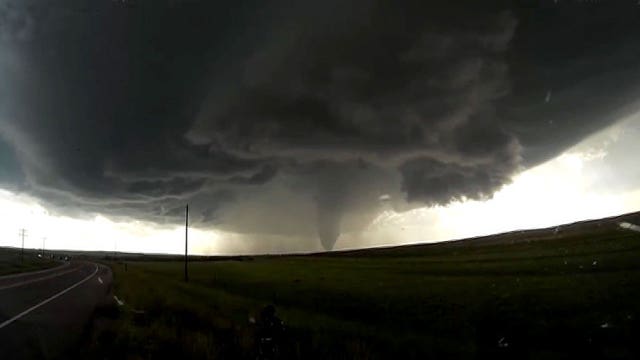These types of thunderstorms are notable for spawning some of the most severe weather.
The National Weather Service (NWS) says supercells are "perhaps the most violent" of all types of severe thunderstorms, capable of producing damaging winds, large hail and weak to violent tornadoes.
"What makes a supercell unique from all other thunderstorm types is that it contains a deep and persistent rotating updraft called a mesocyclone," the NWS forecast office in Amarillo, Texas, states. "If the environment is favorable, supercell thunderstorms can last for several hours."
WHAT IS A SQUALL LINE? WHAT TO KNOW ABOUT THIS THREATENING WEATHER
These types of storms tend to form across the central part of the U.S., where warm, moist air from the Gulf of Mexico collides with cold dry air from Canada.

Supercells are "perhaps the most violent" of all types of severe thunderstorms,. (iStock)
That battleground of air masses can happen in the Southeast in late winter and early spring, before shifting into the Plains states by May.
The National Oceanic and Atmospheric Administration's (NOAA) National Severe Storms Laboratory (NSSL) said supercells are long-lived and a "highly organized" storms that feed off what is known as an updraft, a rising column of air that is both tilted and rotating.

The features of a classic supercell thunderstorm. (National Severe Storms Laboratory)
"This rotating updraft – as large as 10 miles in diameter and up to 50,000 feet tall – can be present as much as 20 to 60 minutes before a tornado forms," the NSSL states. "Scientists call this rotation a mesocyclone when it is detected by Doppler radar."
SEVERE THUNDERSTORM DANGERS: WHY YOU SHOULD TAKE WARNINGS SERIOUSLY
What is visible on the ground as a tornado is actually a "very small extension" of the larger rotation within these thunderstorms.
"Most large and violent tornadoes come from supercells," according to the NSSL.
CLICK HERE FOR MORE WEATHER COVERAGE FROM FOX NEWS
Supercell storms tend to have several features, including a tall, overshooting top and an anvil cloud.
Not all the storms will resemble a classic supercell, but they still bring the threat of rain, hail, damaging winds and possible tornadoes.










































